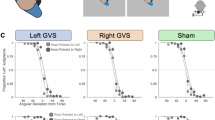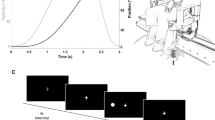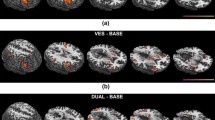Abstract
The vestibular system analyses angular and linear accelerations of the head that are important information for perceiving the location of one’s own body in space. Vestibular stimulation and in particular galvanic vestibular stimulation (GVS) that allow a systematic modification of vestibular signals has so far mainly been used to investigate vestibular influence on sensori-motor integration in eye movements and postural control. Comparatively, only a few behavioural and imaging studies have investigated how cognition of space and body may depend on vestibular processing. This study was designed to differentiate the influence of left versus right anodal GVS compared to sham stimulation on object-based versus egocentric mental transformations. While GVS was applied, subjects made left-right judgments about pictures of a plant or a human body presented at different orientations in the roll plane. All subjects reported illusory sensations of body self-motion and/or visual field motion during GVS. Response times in the mental transformation task were increased during right but not left anodal GVS for the more difficult stimuli and the larger angles of rotation. Post-hoc analyses suggested that the interfering effect of right anodal GVS was only present in subjects who reported having imagined turning themselves to solve the mental transformation task (egocentric transformation) as compared to those subjects having imagined turning the picture in space (object-based mental transformation). We suggest that this effect relies on shared functional and cortical mechanisms in the posterior parietal cortex associated with both right anodal GVS and mental imagery.





Similar content being viewed by others
Notes
The upright (0°) and the upside-down conditions (180°) were not included in this first ANOVA since they cannot be assigned to either a clockwise or counterclockwise Stimulus Orientation and subjects reported having used other strategies than mental rotation for the 180°angle (see below).
References
Bächtold D, Baumann T, Sandor PS, Kritos M, Regard M, Brugger P (2001) Spatial- and verbal-memory improvement by cold-water caloric stimulation in healthy subjects. Exp Brain Res 136:128–132
Bent LR, McFadyen BJ, Merkley VF, Kennedy PM, Inglis JT (2000) Magnitude effects of galvanic vestibular stimulation on the trajectory of human gait. Neurosci Lett 279:157–160
Blanke O, Landis T, Spinelli L, Seeck M (2004) Out-of-body experience and autoscopy of neurological origin. Brain 127:243–258
Blanke O, Mohr C, Michel CM, Pascual-Leone A, Brugger P, Seeck M, Landis T, Thut G (2005) Linking out-of-body experience and self processing to mental own-body imagery at the temporoparietal junction. J Neurosci 25:550–557
Blanke O, Ortigue S, Landis T, Seeck M (2002) Stimulating illusory own-body perceptions. Nature 419:269–270
Bottini G, Paulesu E, Gandola M, Loffredo S, Scarpa P, Sterzi R, Santilli I, Defanti CA, Scialfa G, Fazio F, Vallar G (2005) Left caloric vestibular stimulation ameliorates right hemianesthesia. Neurology 65:1278–1283
Brainard DH (1997) The psychophysics toolbox. Spatial Vision 10:443–446
Brandt T, Schautzer F, Hamilton DA, Bruning R, Markowitsch HJ, Kalla R, Darlington C, Smith P, Strupp M (2005) Vestibular loss causes hippocampal atrophy and impaired spatial memory in humans. Brain 128:2732–2741
Cappa S, Sterzi R, Vallar G, Bisiach E (1987) Remission of hemineglect and anosognosia during vestibular stimulation. Neuropsychologia 25:775–782
Cooper L (1975) Mental rotation of random two-dimensional shapes. Cogn Psychol 7:20–43
Creem SH, Downs TH, Wraga M, Harrington GS, Proffitt DR, Downs JH 3rd (2001) An fMRI study of imagined self-rotation. Cogn Affect Behav Neurosci 1:239–249
Devinsky O, Feldmann E, Burrowes K, Bromfield E (1989) Autoscopic phenomena with seizures. Arch Neurol 46:1080–1088
Fink GR, Marshall JC, Weiss PH, Stephan T, Grefkes C, Shah NJ, Zilles K, Dieterich M (2003) Performing allocentric visuospatial judgments with induced distortion of the egocentric reference frame: an fMRI study with clinical implications. Neuroimage 20:1505–1517
Fitzpatrick RC, Day BL (2004) Probing the human vestibular system with galvanic stimulation. J Appl Physiol 96:2301–2316
Fitzpatrick RC, Marsden J, Lord SR, Day BL (2002) Galvanic vestibular stimulation evokes sensations of body rotation. Neuroreport 13:2379–83
George MS, Wassermann EM, Post RM (1996) Transcranial magnetic stimulation: a neuropsychiatric tool for the 21st century. J Neuropsychiatry Clin Neurosci 8:373–382
Glasauer S, Amorim MA, Viaud-Delmon I, Berthoz A (2002) Differential effects of labyrinthine dysfunction on distance and direction during blindfolded walking of a triangular path. Exp Brain Res 145:489–497
Grabherr L, Bach S, Indermaur K, Metzler S, Mast F (2007) Mental transformations of bodies and body-parts in microgravity. J Vest Res (in press)
Hartley T, Maguire EA, Spiers HJ, Burgess N (2003) The well-worn route and the path less traveled: distinct neural bases of route following and wayfinding in humans. Neuron 37:877–888
Jordan K, Wustenberg T, Heinze HJ, Peters M, Jancke L (2002) Women and men exhibit different cortical activation patterns during mental rotation tasks. Neuropsychologia 40:2397–2408
Kahane P, Hoffmann D, Minotti L, Berthoz A (2003) Reappraisal of the human vestibular cortex by cortical electrical stimulation study. Ann Neurol 54:615–624
Karnath HO, Dieterich M (2006) Spatial neglect-a vestibular disorder? Brain 129:293–305
Kosslyn SM, DiGirolamo GJ, Thompson WL, Alpert NM (1998) Mental rotation of objects versus hands: neural mechanisms revealed by positron emission tomography. Psychophysiology 35:151–161
Lacour M, Bonnet M, Roll JP (1974) [Spinal effects of electric vestibular stimulation in man. Demonstrated evidence of vestibular prevalence and role in motion laterality]. Acta Otolaryngol 78:399–409
Lane NE, Kennedy, RS (1988) A new method for quantifying simulator sickness: development and application of the simulator sickness questionnaire (SSQ). Technical Report No. EOTR 88-7, Essex Corporation, Orlando
Lenggenhager B, Smith S, Blanke O (2006) Functional and neural mechanisms of embodiment: Importance of the vestibular system and the temporal parietal junction. Rev Neurosci 17:643–657
Lobel E, Kleine JF, Bihan DL, Leroy-Willig A, Berthoz A (1998) Functional MRI of galvanic vestibular stimulation. J Neurophysiol 80:2699–2709
Lopez C, Blanke O (2007) Neuropsychology and neurophysiology of self-consciousness. Multisensory and vestibular mechanisms. In: Holderegger A, Sitter-Liver B, Hess CW (eds) Hirnforschung und Menschenbild. Beiträge zur interdisziplinären Verständigung. Schwabe, Basel
Lopez C, Lacour M, Ballester M, Dumitrescu M, Anton J-L, Nazarian B, Roth M, Borel L (2005) Brain activations during subjective visual vertical judgment: a functional magnetic resonance imaging study. Gait and Posture 21(Suppl 1):13
MacDougall HG, Brizuela AE, Burgess AM, Curthoys IS (2002) Between-subject variability and within-subject reliability of the human eye-movement response to bilateral galvanic (DC) vestibular stimulation. Exp Brain Res 144:69–78
MacDougall HG, Moore ST, Curthoys IS, Black FO (2006) Modeling postural instability with Galvanic vestibular stimulation. Exp Brain Res 172:208–220
Mars F, Vercher JL, Popov K (2005) Dissociation between subjective vertical and subjective body orientation elicited by galvanic vestibular stimulation. Brain Res Bull 65:77–86
Mast FW, Meissner F (2004) Mental transformations of perspective during whole-body roll-rotation. J Vestib Res 14:113
Mast FW, Merfeld DM, Kosslyn SM (2006) Visual mental imagery during caloric vestibular stimulation. Neuropsychologia 44:101–109
Ohlmann T, Marendaz C (1991) Vicarious processes involved in spatial perception. In: Wapner S (ed) Bio-psycho-social factors in cognitive style. Lawrence Erlbaum, Hillsdale, pp 106–129
Oldfield RC (1971) The assessment and analysis of handedness: the Edinburgh inventory. Neuropsychologia 9:97–113
Parsons LM (1987) Imagined spatial transformation of one’s body. J Exp Psychol Gen 116:172–191
Pascual-Leone A, Rubio B, Pallardo F, Catala MD (1996) Rapid-rate transcranial magnetic stimulation of left dorsolateral prefrontal cortex in drug-resistant depression. Lancet 348:233–237
Pelli DG (1997) The VideoToolbox sotware for visual psychophysics: transforming numbers into movies. Spat Vis 10:437–442
Penfield W, Erickson T (1941) Epilepsy and Cerebral Localization, Charles C. Thomas, Springfield
Peruch P, Borel L, Gaunet F, Thinus-Blanc G, Magnan J, Lacour M (1999) Spatial performance of unilateral vestibular defective patients in nonvisual versus visual navigation. J Vestib Res 9:37–47
Peruch P, Borel L, Magnan J, Lacour M (2005) Direction and distance deficits in path integration after unilateral vestibular loss depend on task complexity. Brain Res Cogn Brain Res 25:862–872
Quarck G, Etard O, Normand H, Pottier M, Denise P (1998) Low intensity galvanic vestibulo-ocular reflex in normal subjects. Neurophysiol Clin 28:413–422
Rode G, Charles N, Perenin MT, Vighetto A, Trillet M, Aimard G (1992) Partial remission of hemiplegia and somatoparaphrenia through vestibular stimulation in a case of unilateral neglect. Cortex 28:203–208
Rodionov V, Zislin J, Elidan J (2004) Imagination of body rotation can induce eye movements. Acta Otolaryngol 124:684–689
Saj A, Honore J, Rousseaux M (2006) Perception of the vertical in patients with right hemispheric lesion: Effect of galvanic vestibular stimulation. Neuropsychologia 44:1509–1512
Shepard RN, Metzler J (1971) Mental rotation of three-dimensional objects. Science 171:701–703
Smith PF, Zheng Y, Horii A, Darlington CL (2005) Does vestibular damage cause cognitive dysfunction in humans? J Vestib Res 15:1–9
Stephan T, Deutschlander A, Nolte A, Schneider E, Wiesmann M, Brandt T, Dieterich M (2005) Functional MRI of galvanic vestibular stimulation with alternating currents at different frequencies. Neuroimage 26:721–732
Vallar G (1998) Spatial Hemineglect in Human. Trends Cogn Sci 2:87–97
Vallar G, Lobel E, Galati G, Berthoz A, Pizzamiglio L, Le Bihan D (1999) A fronto-parietal system for computing the egocentric spatial frame of reference in humans. Exp Brain Res 124:281–286
Vingerhoets G, Santens P, Van Laere K, Lahorte P, Dierckx RA, De Reuck J (2001) Regional brain activity during different paradigms of mental rotation in healthy volunteers: a positron emission tomography study. Neuroimage 13:381–391
Vogeley K, Fink GR (2003) Neural correlates of the first-person-perspective. Trends Cogn Sci 7:38–42
Wraga M, Shephard JM, Church JA, Inati S, Kosslyn SM (2005) Imagined rotations of self versus objects: an fMRI study. Neuropsychologia 43:1351–1361
Zacks JM, Michelon P (2005) Transformations of visuospatial images. Behav Cogn Neurosci Rev 4:96–118
Zacks JM, Tversky B (2005) Multiple systems for spatial imagery: transformations of objects and bodies. Spatial Cognit Comput 5:271–306
Zacks J, Rypma B, Gabrieli JD, Tversky B, Glover GH (1999) Imagined transformations of bodies: an fMRI investigation. Neuropsychologia 37:1029–1040
Zink R, Bucher SF, Weiss A, Brandt T, Dieterich M (1998) Effects of galvanic vestibular stimulation on otolithic and semicircular canal eye movements and perceived vertical. Electroencephalogr Clin Neurophysiol 107:200–205
Acknowledgments
This work was supported by the Cogito Foundation, the Fondation de Famille Sandoz, the Fondation Odier de Psychophysique, and the Swiss National Science Foundation. We thank Pär Halje for the programming of the stimuli and Dr. Raphaël Holzer for technical assistance.
Author information
Authors and Affiliations
Corresponding author
Electronic supplementary material
Below is the link to the electronic supplementary material.
Rights and permissions
About this article
Cite this article
Lenggenhager, B., Lopez, C. & Blanke, O. Influence of galvanic vestibular stimulation on egocentric and object-based mental transformations. Exp Brain Res 184, 211–221 (2008). https://doi.org/10.1007/s00221-007-1095-9
Received:
Accepted:
Published:
Issue Date:
DOI: https://doi.org/10.1007/s00221-007-1095-9




